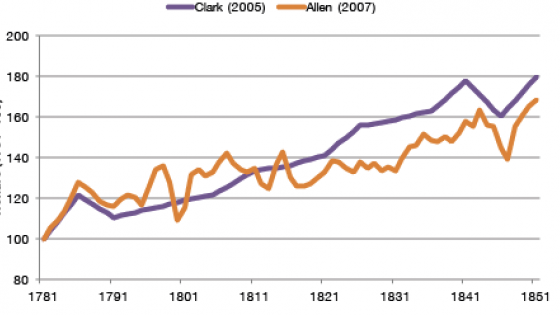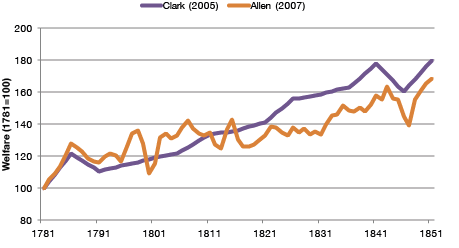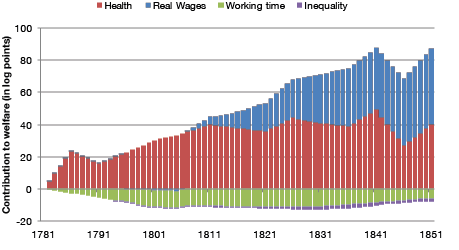Britain was the cradle of the Industrial Revolution and the first country to benefit from more efficient production techniques, yet the consequences of this process for workers’ living standards during the period 1780-1850 remain hotly disputed. Evidence on trends in real wages and working time suggests a period of stagnation for British workers until the late 1810s and a steady improvement thereafter (Clark 2005, Allen 2007, Voth 2001). Meanwhile, life expectancy increased from the late 18th century and stagnated from the 1810s onwards (Wrigley et al. 1997). That period also saw rising levels of inequality (Williamson 1985). On top of this, the rate of increase in real wages after the Napoleonic Wars is disputed too, as the estimates of Clark (2005) show a 75% larger improvement than that of Allen (2007) from the 1770s to the 1860s.
One of the reasons for the lack of consensus in the literature is that most studies have analysed these various aspects of human wellbeing in isolation. This provides a one-sided account of a multi-dimensional concept, which is especially problematic when the various aspects show differing trends. To overcome this problem, in a new paper I propose the application of a procedure by Jones and Klenow (forthcoming) to create a new composite indicator of British living standards that jointly considers income, health, working time and inequality for the period 1781-1851 (Gallardo-Albarrán 2016).
Towards a new framework for the study of living standards in the past
This new methodology supposes a significant improvement over other widely used composite measures such as the Human Development Index since its weighting scheme is not chosen arbitrarily but is calculated according to theoretically defined principles. By using an expected utility framework, positive (or negative) changes in income, health, working time and inequality are translated into positive (or negative) utility flows that can be measured and combined to obtain an overall picture of the evolution of living standards.
Figure 1 presents the results of this new framework using both the optimistic wage series of Clark (2005) and the more pessimistic series of Allen (2007) to assess the impact of these different views on the final index. Using either series, the wellbeing of an average British worker shows a steady upward trend throughout most of the period.
This has two implications. First, choosing one wage series over the other does not change the overall picture when other aspects of living standards are included. Second, the new composite measure does not exhibit a two-phase trend as its components considered individually suggest, but rather a constant improvement until the 1840s.
Figure 1. The development of wellbeing in Britain, 1781-1851
Notes: to account for the dimension of health I use life expectancy at birth from Wrigley et al (1997), for working time I draw on Voth (2001) and for inequality I draw on Williamson (1985). To assess the importance of different real wage estimates in the literature, I created two welfare indices: one using the optimistic real wage series from Clark (2005) and the other using the more pessimistic series from Allen (2007).
To identify the forces behind the development shown by the new composite measure, Figure 2 provides a welfare decomposition so that for each year, one can observe the positive or negative contribution of income, health, working time and inequality to wellbeing, with 1781 as the reference year. The reason why real wages alone underestimate the rise in living standards is because life expectancy at birth had increased by approximately five years by the end of the period. That achievement increased welfare by as much as the increase in real wages.
Why do we observe a steady increase in wellbeing? From the beginning of the period until 1810, gains in health improve welfare, despite stagnant wages and longer working hours. In the subsequent years, life expectancy ceases to increase because of rapid urbanisation and its associated maladies. In that period, real wages become the main driver of welfare improvements. At the same time, the levels of inequality increase but the negative effect thereof on wellbeing is offset by a decreasing trend in the number of annual hours worked after 1830.
The steady improvement in living standards during the period 1781-1851 might at first glance support the optimists´ case; however, Figures 1 and 2 both show that welfare no longer increases after 1840, when productivity gains accelerated in Britain and their benefits trickled down to the working classes in the form of higher real wages. A closer look at the forces driving this process reveals that the health toll paid by a growing urban population together with long working hours and rising inequality hampered progress in wellbeing. As a result, the lives of the working class would not dramatically improve until the late 19th century when gains in real wages were paralleled by significant reductions in mortality, shorter working hours and lower levels of inequality.
Figure 2. Welfare decomposition, 1781-1851
Note: see Figure 1 for the data used on health, working time and inequality. For real wages, I use the series of Clark (2005).
Studying the consequences of past and future economic development
What lessons can be drawn from the application of a new welfare measure to the British living standards debate? First, to understand the far-reaching consequences of industrialisation and urbanisation for peoples’ wellbeing, the separate analysis of its dimensions needs to be complemented with a theoretically grounded framework that measures them in the same units. This approach not only allows for the assessment of different views on the evolution of a single dimension and its implications for overall welfare (e.g. different views on income trends), but it also helps in identifying which aspects of welfare deserve special consideration, such as health in the British case.
Second, development paths and their consequences for the majority of the population are manifold. The British experience shows that industrialisation per se does not bring immediate gains in living standards if industrialisation is not accompanied by policies that improve public health, prevent the labour exploitation of adults and children alike, and make productivity gains more inclusive via education and redistribution policies (among others).
In this sense, the application of a composite welfare measure to Britain during the Industrial Revolution not only informs us about how we got where we are today, but it also sheds light on the reasons why some countries have benefitted more than others during the complex process of economic development; a process that can be better understood by taking a composite perspective and going beyond income measures alone.
References
Allen, R. (2007). "Pessimism preserved: Real Wages in the British Industrial Revolution" (Working paper No. 314). Retrieved from the Oxford University Department of Economics website.
Clark, G. (2005). "The Condition of the Working Class in England, 1209-2004". Journal of Political Economy, 113 (6), 1307-1340.
Gallardo-Albarrán, D. (2016). "A composite perspective on British living standards during the Industrial Revolution". Groningen Growth and Development Centre Research Memorandum, nr. 159
Jones, C. I., & Klenow, P. J. (forthcoming). "Beyond GDP? Welfare across countries and time". American Economic Review.
Voth, H.-J. (2001). "Time and Work in Eighteenth- Century London". Journal of Economic History, 58 (1), 29-58.
Williamson, J. G. (1985). Did British Capitalism Breed Inequality? Boston: Allen & Unwin.
Wrigley, E. A., Davies, R. S., Oeppen, J. E., & Schofield, R. S. (1997). English Population History from Family Reconstitution 1580-1837. Cambridge: Cambridge University Press.





